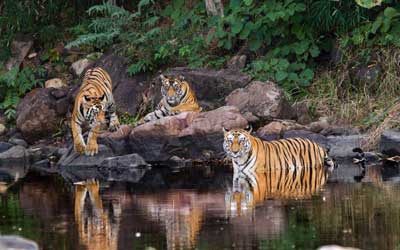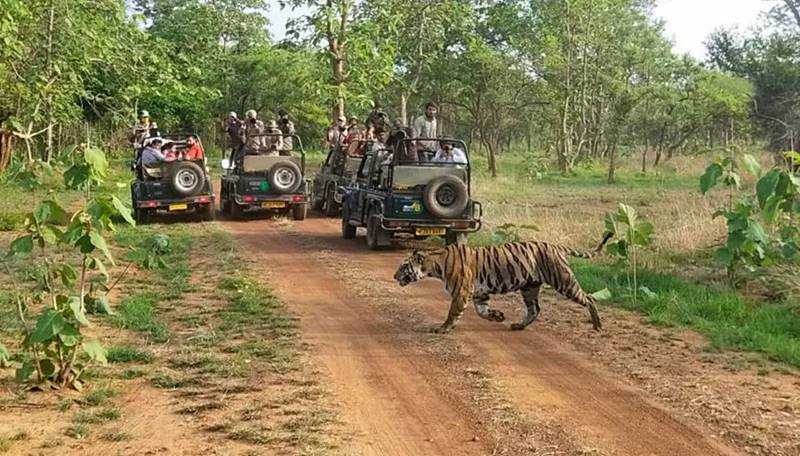
During the winter months at Panna National Park, visitors can expect to see a rich variety of wildlife, thanks to the park's diverse ecosystems and cooler weather that encourages animal activity. Here’s a detailed overview of the wildlife you might encounter:

Mammals
- Royal Bengal Tiger: Panna is known for its significant tiger population. Winter is an excellent time for spotting these majestic big cats as they are more active during the cooler parts of the day.
- Indian Leopard: These elusive predators can often be seen resting in trees or moving stealthily through the underbrush.
- Sloth Bear: Known for their shaggy fur and unique foraging habits, sloth bears are more visible during this season as they search for food.
- Nilgai (Blue Bull): The largest antelope in India, nilgai are commonly spotted grazing in open areas and near water sources.
- Chital (Spotted Deer): Frequently seen in herds, chital are abundant in the park and often gather near water bodies, making them a common sight.
- Sambar Deer: This larger deer species prefers denser forests and can often be seen near water sources, especially during the cooler months.
- Chinkara (Indian Gazelle): Smaller than nilgai, chinkara can be spotted in the park's grasslands, particularly during dawn and dusk.
- Wild Dogs (Dhole): These social animals may be seen hunting in packs, especially in the early morning or late evening.
- Hyena: Though elusive, hyenas can occasionally be spotted scavenging or hunting during dusk.
Birds
Panna National Park is also a birdwatcher's paradise with over 300 species recorded:
- Crested Honey Buzzard: Often seen soaring above the park, this bird is known for its distinctive appearance and hunting skills.
- King Vulture: A striking scavenger that can be spotted around carcasses, particularly during winter when food sources are concentrated.
- Blossom-Headed Parakeet: These colorful birds add vibrancy to the park's avifauna and can often be seen in flocks.
- Hawk-Eagle: A powerful raptor that hunts smaller birds and mammals; winter offers good visibility for spotting these birds.
- Bar-Headed Goose: Frequently found near water bodies as they migrate through the region during winter months.
- Red-Headed Vulture: Another scavenger that plays a vital role in the ecosystem by cleaning up carcasses.
Reptiles
While reptiles may be less active in cooler weather, some species can still be observed:
- Indian Python: Occasionally seen basking in the sun or near water sources in search of prey.
- Gharial: This fish-eating crocodile can be found in the Ken River within the park.
Unique Experiences
Winter also allows for night safaris in certain areas of Panna National Park, where visitors may encounter nocturnal wildlife such as:
- Rusty-Spotted Cat: One of the smallest wild cats, often active at night and elusive to spot during daytime hours.
- Mottled-Wood Owl: Known for its distinctive call and beautiful plumage, this owl adds to the park's nocturnal diversity.
Conclusion
Winter at Panna National Park provides an exceptional opportunity to observe a wide variety of wildlife in their natural habitat. The combination of cooler temperatures encouraging animal activity and reduced foliage enhancing visibility makes this season ideal for wildlife enthusiasts and photographers alike. Whether you're tracking tigers or birdwatching, Panna offers a memorable experience amidst India's rich biodiversity.

































